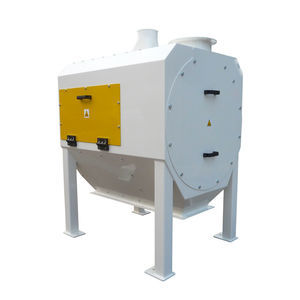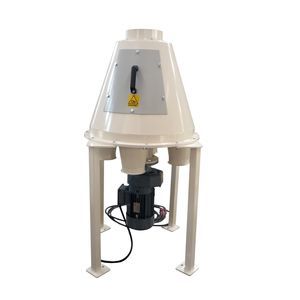
- Products
- Catalogs
- News & Trends
- Exhibitions
Rotary separator GRTScerealsandfor the food industry



Add to favorites
Compare this product
Characteristics
- Technology
- rotary
- Separated substance
- sand, cereal
- Application domain
- for the food industry
- Other characteristics
- stainless steel, iron
Description
The GRTS ROTO SEPARATOR is used in cleaning sections to separate impurities from cereals.
The separation takes place by grain-size: the cereal flows over a first perforated screen where it falls through the holes. Larger impurities remain above the screen and flow towards the large scraps exit.
The cereal then falls into a second sifting below, with narrower holes, where it remains, sliding until discharged. The finer parts instead (such as sand, soli etc.) pass in the holes and are then carried in the appropriate outlet.
The machine consists mainly of:
• a central, oscillating body, connected to a fixed structure by fiberglass rods that allow it to move. This element contains and mechanically blocks the sieving frames;
• a rotating counterweight, operated by an electric motor, that determines the movement of the central part;
• one or more upper frames for the separation of large parts, structurally constructed in tubular iron or stainless steel, fixing the sheet or sieving net.
• one or more lower frames for the separation of fine parts and powders, built of iron or stainless steel tubulars, fixing the sheet or sieving net.
Screening sheets are easily and quickly removable from the back for maintenance, replacement and modification of screening openings.
Generally, the machine is paired with a fanning mill to get a further elimination of the light fractions. In this case, the fanning mill is applied to the discharge of the roto separator and can also be equipped with a magnetic device.
Related Searches
- Solid classifier
- Pressure separator filter
- Centrifugal classifier
- Compressed air separator filter
- Dust pre-filter
- Classifier for the food industry
- Decanter centrifuge
- Easy cleaning pre-filter
- Horizontal decanter
- Air classifier
- Particulate separator filter
- Dust separator filter
- Stainless steel separator
- Cylindrical separator filter
- Washable pre-filter
- Sand classifier
- Decanter for the food industry
- Iron separator
- Cross flow filter
- Sleeve filter
*Prices are pre-tax. They exclude delivery charges and customs duties and do not include additional charges for installation or activation options. Prices are indicative only and may vary by country, with changes to the cost of raw materials and exchange rates.









